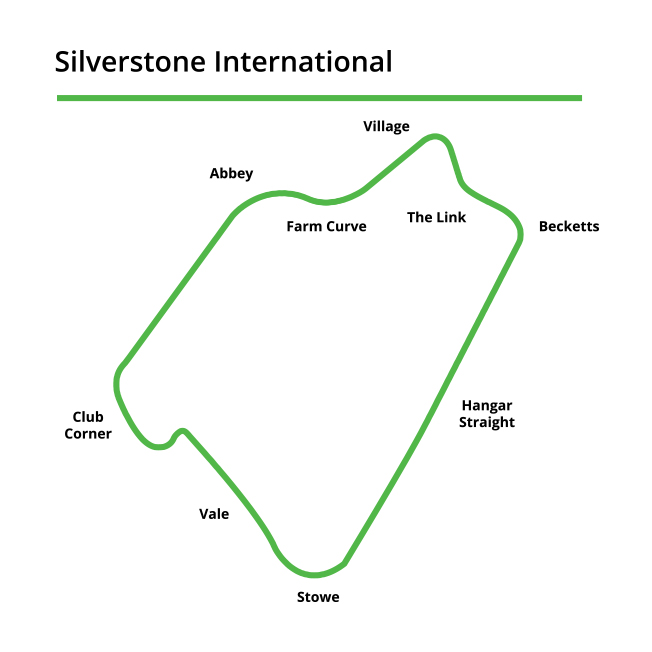Silverstone International
Silverstone International circuit is a motor racing circuit in England next to Northamptonshire villages of Silverstone and Whittlebury. Always one of the fastest circuits, Silverstone has developed from its windswept airfield origins into one of the most recognised in world motorsport.
At 1.8 miles, the Silverstone International circuit is actually the southern loop of the famous Grand Prix track which includes the Hangar Straight.

Corner one and two – Abbey & Farm Curve
The first turn leads into a fast committed sequence of corners. Getting the correct line is important to help prevent running wide too early and having to lift off the power mid-corner and lose time. Braking point for this turn is approximately a car’s length down the left-hand curb before a smooth turn in and picking up a mid to late apex (use all the flat part of the inside curb).
You will carry the speed through Abbey corner into turn two (Farm Curve) which should be a flat out corner. Make sure you bring the car over to the left curb for a late apex, and allow the car to run to the middle of the track on the exit before bringing the car over to the left ready for the hairpin corner at turn three.
Corner three – Village
This tight right-handed hairpin can be either a 2nd or 3rd gear corner. It is important to trail brake right into the apex so you can keep the weight on the front wheels to help with the tight turn in – ease the power in smoothly then hard.
It is not important to use all the width of the track on the exit as you need to bring the car back 3/4’s to the right ready for the next corner which is another tight hairpin turning left.
Aim to clip the left curb/apex and ignore the bump in the track as you exit this corner – but it’s a nice “ s “ shaped sequence of corners.
Corner four – the Link
This is the most important corner on the Silverstone International layout as it leads onto the longest straight of the circuit – Hanger straight where you can gain or lose a lot of time.
It’s all about getting the correct turn in point so you clip the apex, trying to keep the car as balanced as possible so you don’t get too much oversteer and lose the momentum, but also using all the exit available to reduce the steering angle as early as possible and maximising the power and speed onto the straight.
Braking for this corner is only a medium pressure and not a heavy brake.
Corner five – Stowe
Braking point for this corner is close to the start of the curb on the left and the turn in point is just before the end of the curb. Then turn in to the corner nice and slow, which will help to bring the car in for a late apex as the corner tightens up on the exit. This will help to prevent running wide. Then it will be full power onto a short straight down to the tight left Vale corner.
Corner six – Vale
On the approach to this corner, there is an arrow board on the right-hand side of the track that you can use as a rough breaking point. Like the other hairpins, it’s important to trail brake all the way to the apex.
Turn in point for this left turn is towards the end of the right-hand curb, allowing the car to run to the middle of the track on the exit of the left turn. This will help with the line into the next right turn.
Corner seven – club
Approaching the last corner of the Silverstone International layout is important as it leads onto the pit straight. Turn in point for this corner is just before the end of the left curb, but the steering very nearly stays on a continuous curve from the previous turn. It is important to use the flat part of the inside apex curb; be careful not to hit the large sausage curb on the inside otherwise it will launch the car.
Contact us to book an instructor Find out more about our private tuition

